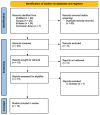Enhancing Root Canal Disinfection with Er:YAG Laser: A Systematic Review
- PMID: 40136729
- PMCID: PMC11941447
- DOI: 10.3390/dj13030101
Enhancing Root Canal Disinfection with Er:YAG Laser: A Systematic Review
Abstract
Background: The quest for minimally invasive disinfection in endodontics has led to using Erbium:Yttrium-Aluminum-Garnet (Er:YAG) lasers. Conventional approaches may leave bacterial reservoirs in complex canal anatomies. Er:YAG's strong water absorption generates photoacoustic streaming, improving smear layer removal with lower thermal risk than other laser systems. Methods: This systematic review followed PRISMA 2020 guidelines. Database searches (PubMed/MEDLINE, Embase, Scopus, Cochrane Library) identified studies (2015-2025) on Er:YAG laser-assisted root canal disinfection. Fifteen articles met the inclusion criteria: antibacterial efficacy, biofilm disruption, or smear layer removal. Data on laser settings, irrigants, and outcomes were extracted. The risk of bias was assessed using a ten-item checklist, based on guidelines from the Cochrane Handbook for Systematic Reviews of Interventions. Results: All studies found Er:YAG laser activation significantly improved root canal disinfection over conventional or ultrasonic methods. Photon-induced photoacoustic streaming (PIPS) and shock wave-enhanced emission photoacoustic streaming (SWEEPS) yielded superior bacterial reduction, especially apically, and enabled lower sodium hypochlorite concentrations without sacrificing efficacy. Some research indicated reduced post-operative discomfort. However, protocols, laser parameters, and outcome measures varied, limiting direct comparisons and emphasizing the need for more standardized, long-term clinical trials. Conclusions: Er:YAG laser-assisted irrigation appears highly effective in biofilm disruption and smear layer removal, supporting deeper irrigant penetration. While findings are promising, further standardized research is needed to solidify guidelines and confirm Er:YAG lasers' long-term clinical benefits.
Keywords: Er:YAG laser; PIPS; SWEEPS; endodontics; photoacoustic streaming; root canal disinfection; smear layer removal.
Conflict of interest statement
The authors declare no conflicts of interest.
Similar articles
-
Antibacterial and Smear Layer Removal Efficacy of Er:YAG Laser Irradiation by Photon-Induced Photoacoustic Streaming in Primary Molar Root Canals: A Preliminary Study.Photomed Laser Surg. 2018 Sep;36(9):480-486. doi: 10.1089/pho.2017.4369. Epub 2018 Jun 15. Photomed Laser Surg. 2018. PMID: 29905503
-
In vitro efficacy of Er:YAG laser-activated irrigation versus passive ultrasonic irrigation and sonic-powered irrigation for treating multispecies biofilms in artificial grooves and dentinal tubules: an SEM and CLSM study.BMC Oral Health. 2024 Feb 22;24(1):261. doi: 10.1186/s12903-024-04042-x. BMC Oral Health. 2024. PMID: 38389109 Free PMC article.
-
Bactericidal Efficacy of Photon-Induced Photoacoustic Streaming-Erbium:Yttrium-Aluminum-Garnet Laser Combined with Irrigation Solution on Enterococcus faecalis in Curved Root Canals: An In Vitro Study.Photobiomodul Photomed Laser Surg. 2022 Jul;40(7):499-506. doi: 10.1089/photob.2022.0009. Photobiomodul Photomed Laser Surg. 2022. PMID: 35867120
-
The Efficiency of the Er: YAG Laser and PhotonInduced Photoacoustic Streaming (PIPS) as an Activation Method in Endodontic Irrigation: A Literature Review.J Lasers Med Sci. 2020 Summer;11(3):316-334. doi: 10.34172/jlms.2020.53. Epub 2020 Jun 21. J Lasers Med Sci. 2020. PMID: 32802294 Free PMC article. Review.
-
Disinfection of Contaminated Canals by Different Laser Wavelengths, while Performing Root Canal Therapy.J Lasers Med Sci. 2013 Winter;4(1):8-16. J Lasers Med Sci. 2013. PMID: 25606301 Free PMC article. Review.
Cited by
-
Antimicrobial Efficacy of Nd:YAG Laser in Polymicrobial Root Canal Infections: A Systematic Review of In Vitro Studies.Int J Mol Sci. 2025 Jun 12;26(12):5631. doi: 10.3390/ijms26125631. Int J Mol Sci. 2025. PMID: 40565094 Free PMC article. Review.
-
Antibacterial and Bactericidal Effects of the Er: YAG Laser on Oral Bacteria: A Systematic Review of Microbiological Evidence.J Funct Biomater. 2025 Jun 3;16(6):209. doi: 10.3390/jfb16060209. J Funct Biomater. 2025. PMID: 40558896 Free PMC article. Review.
-
The influence of cavity configuration and irrigation activation on root canal smear removal-an in vitro study.PeerJ. 2025 Jul 8;13:e19678. doi: 10.7717/peerj.19678. eCollection 2025. PeerJ. 2025. PMID: 40656943 Free PMC article.
References
-
- Hülsmann M. Effects of mechanical instrumentation and chemical irrigation on the root canal dentin. Endod. Top. 2013;29:55–86. doi: 10.1111/etp.12047. - DOI
Publication types
LinkOut - more resources
Full Text Sources
Miscellaneous


